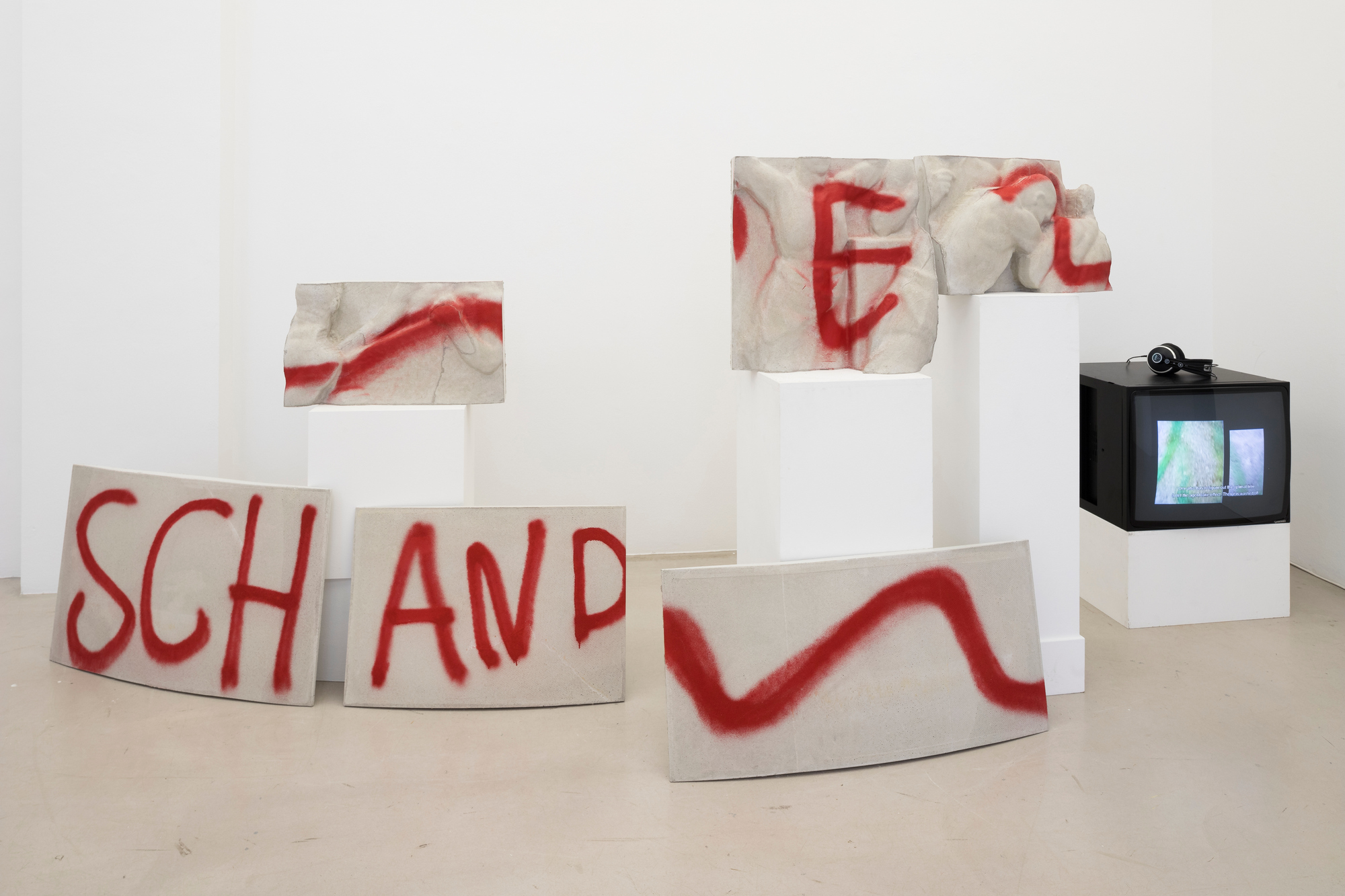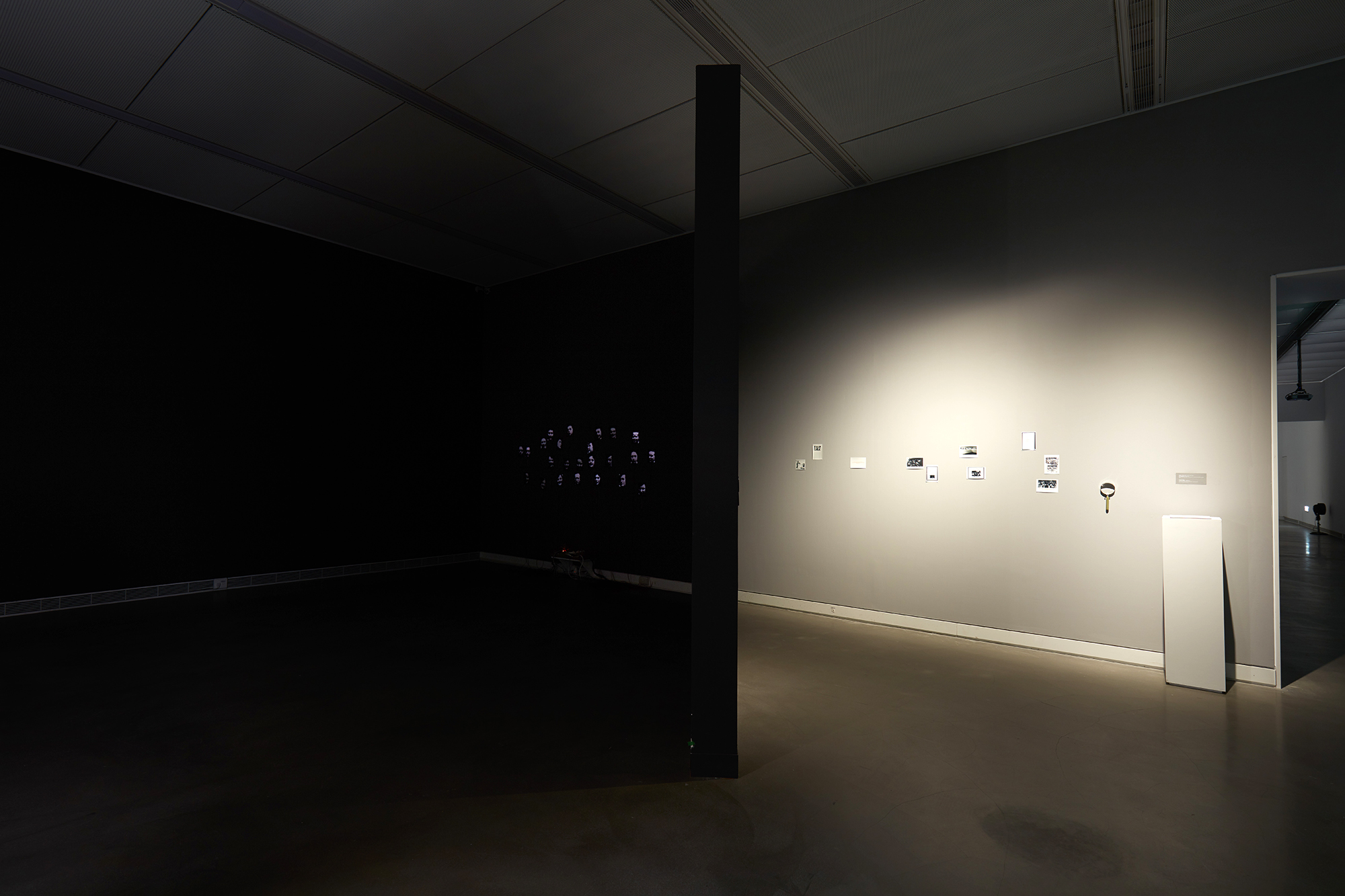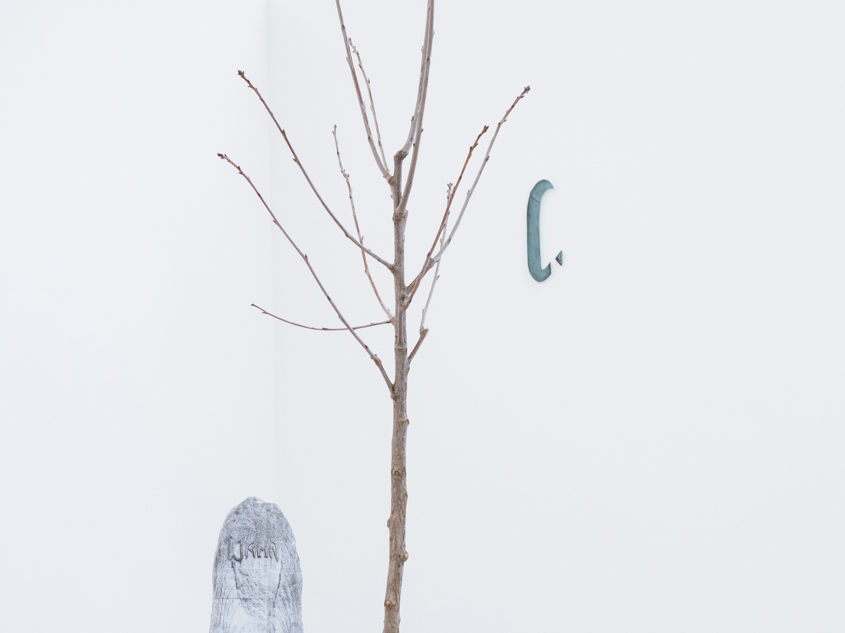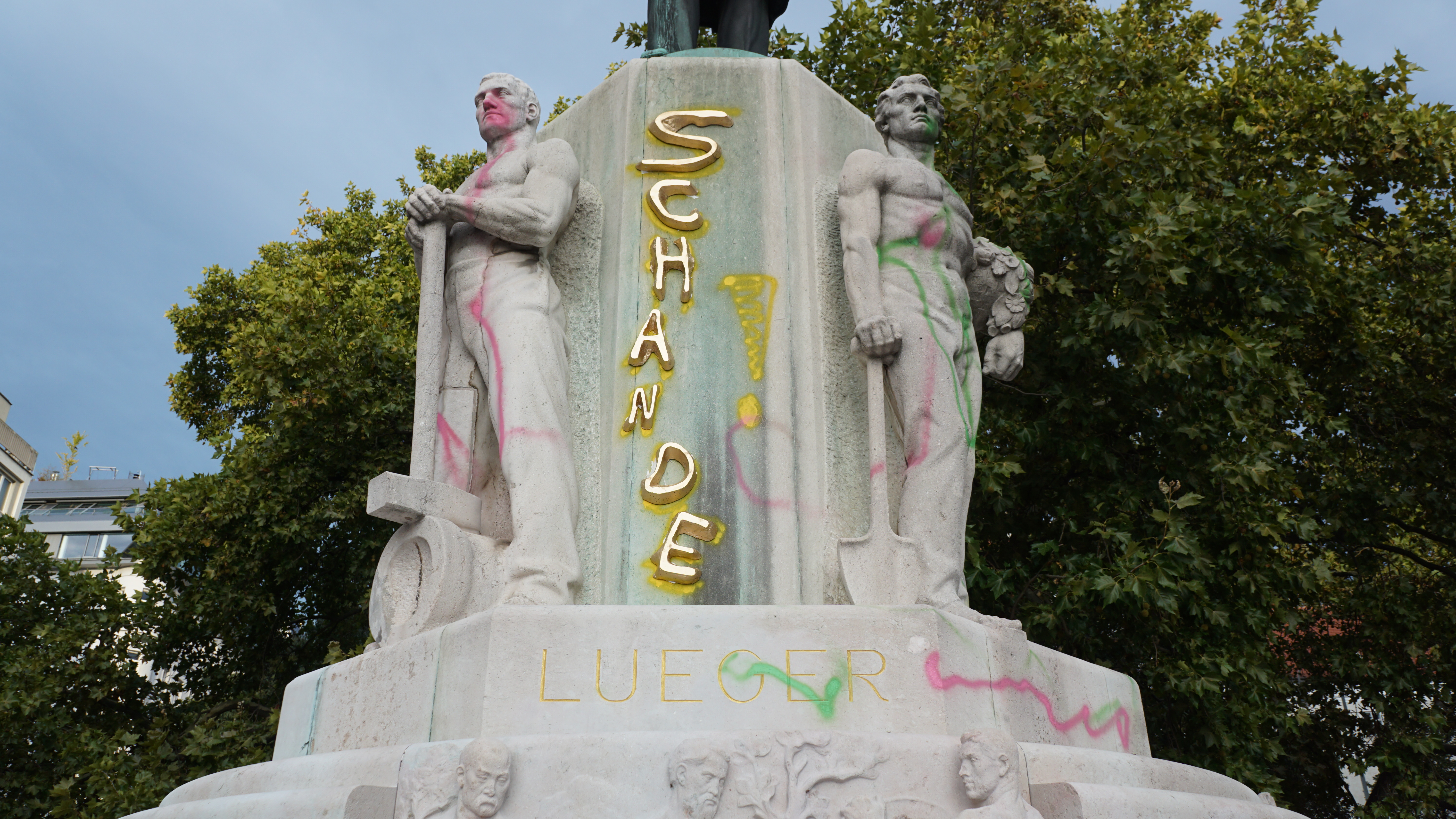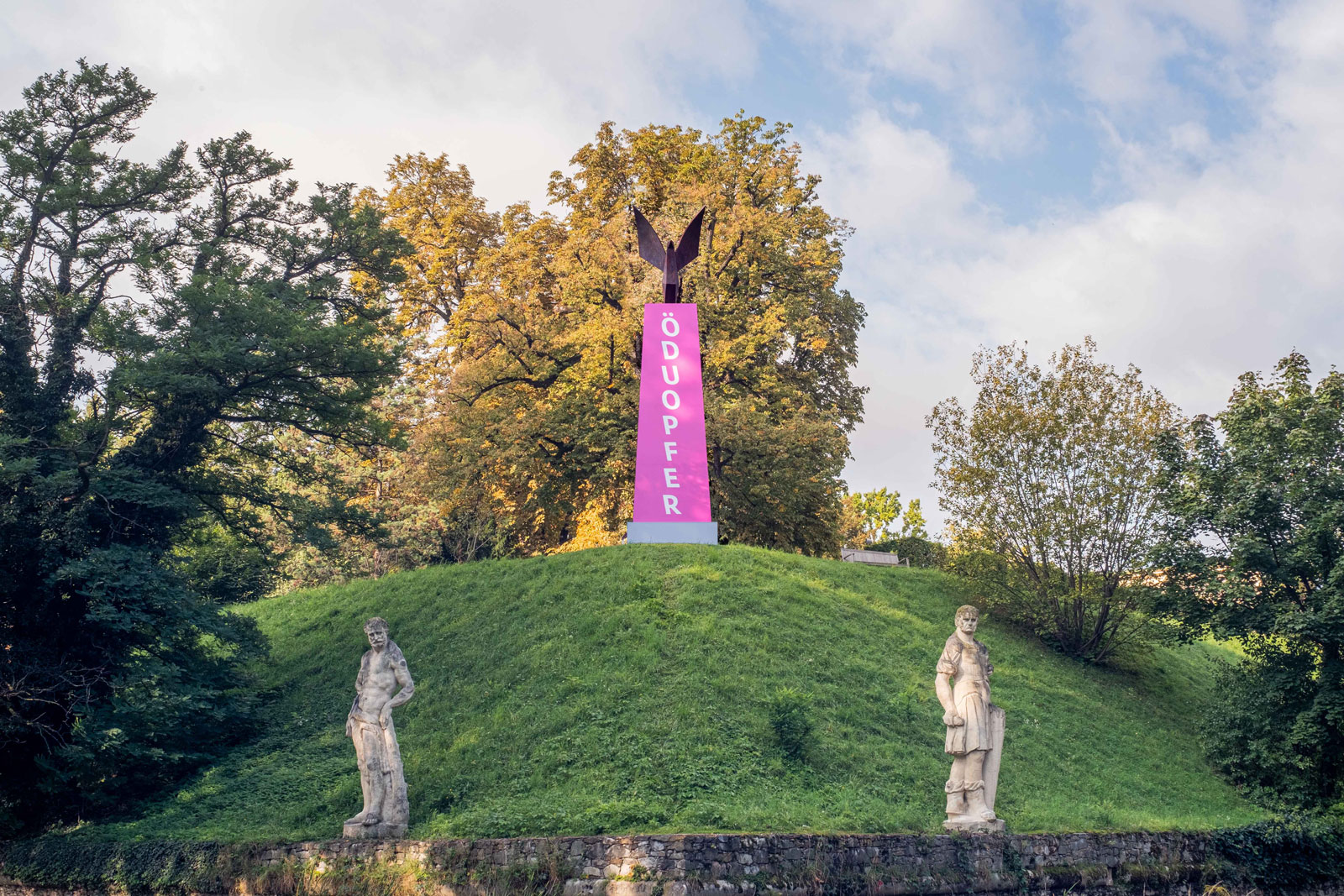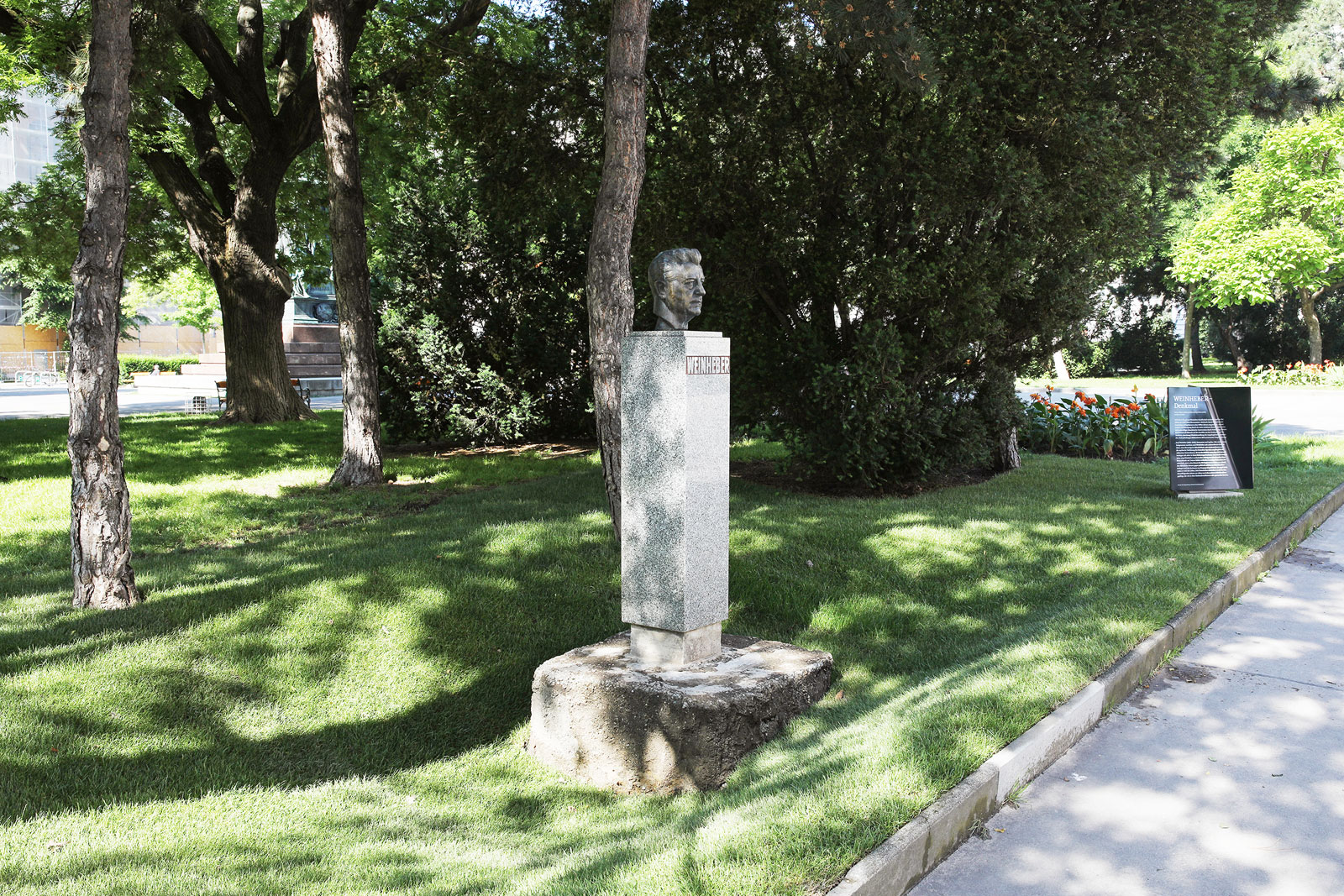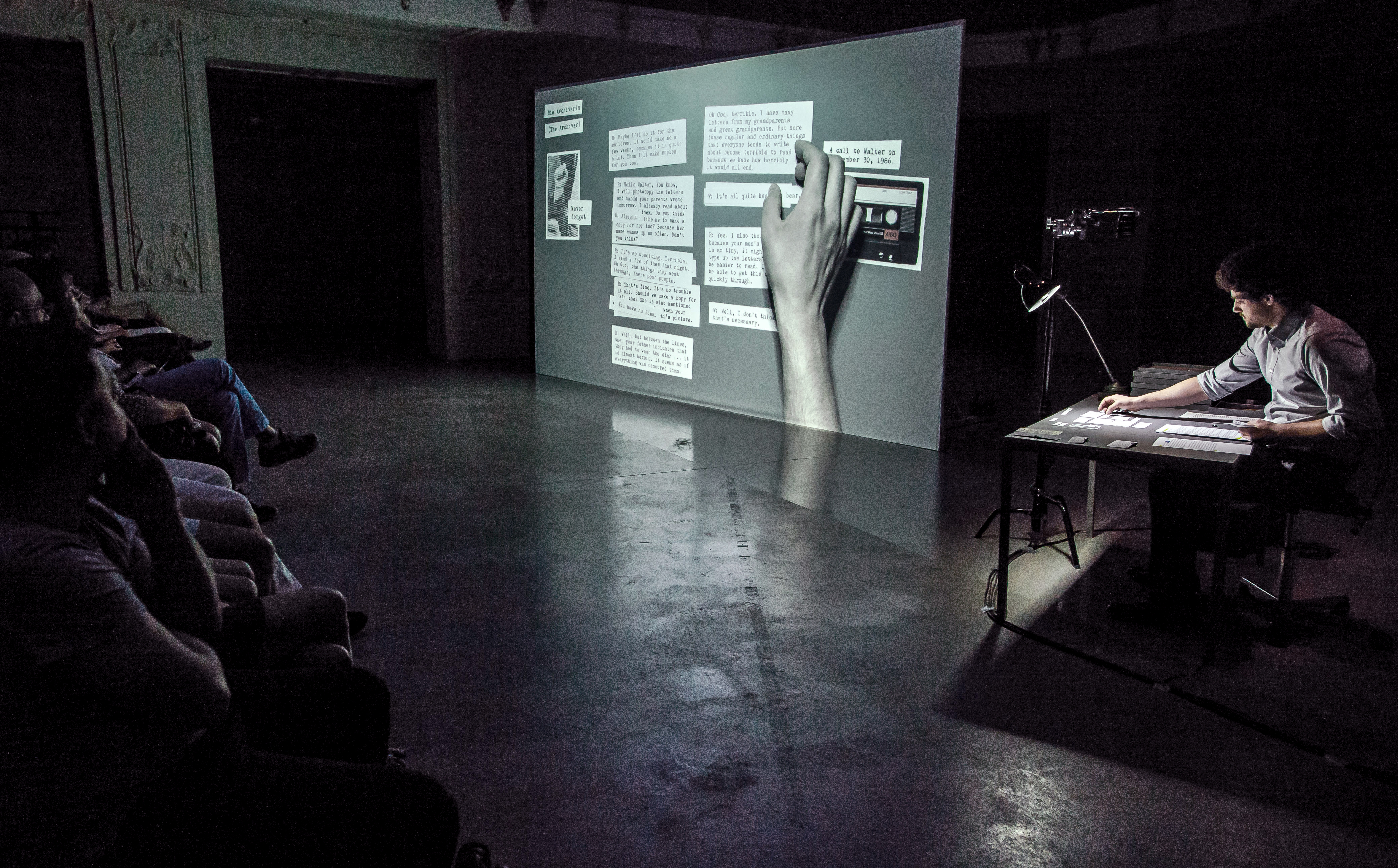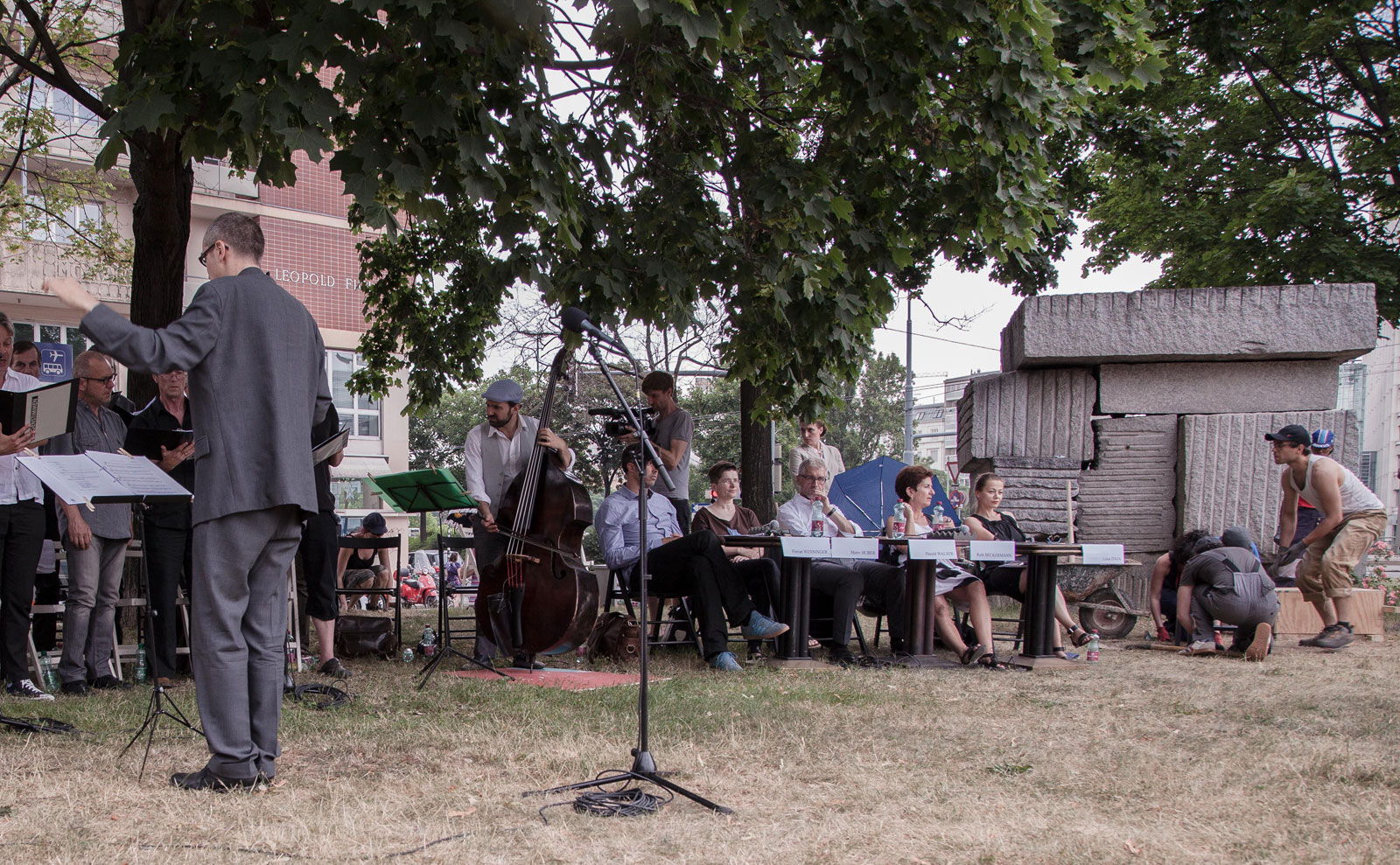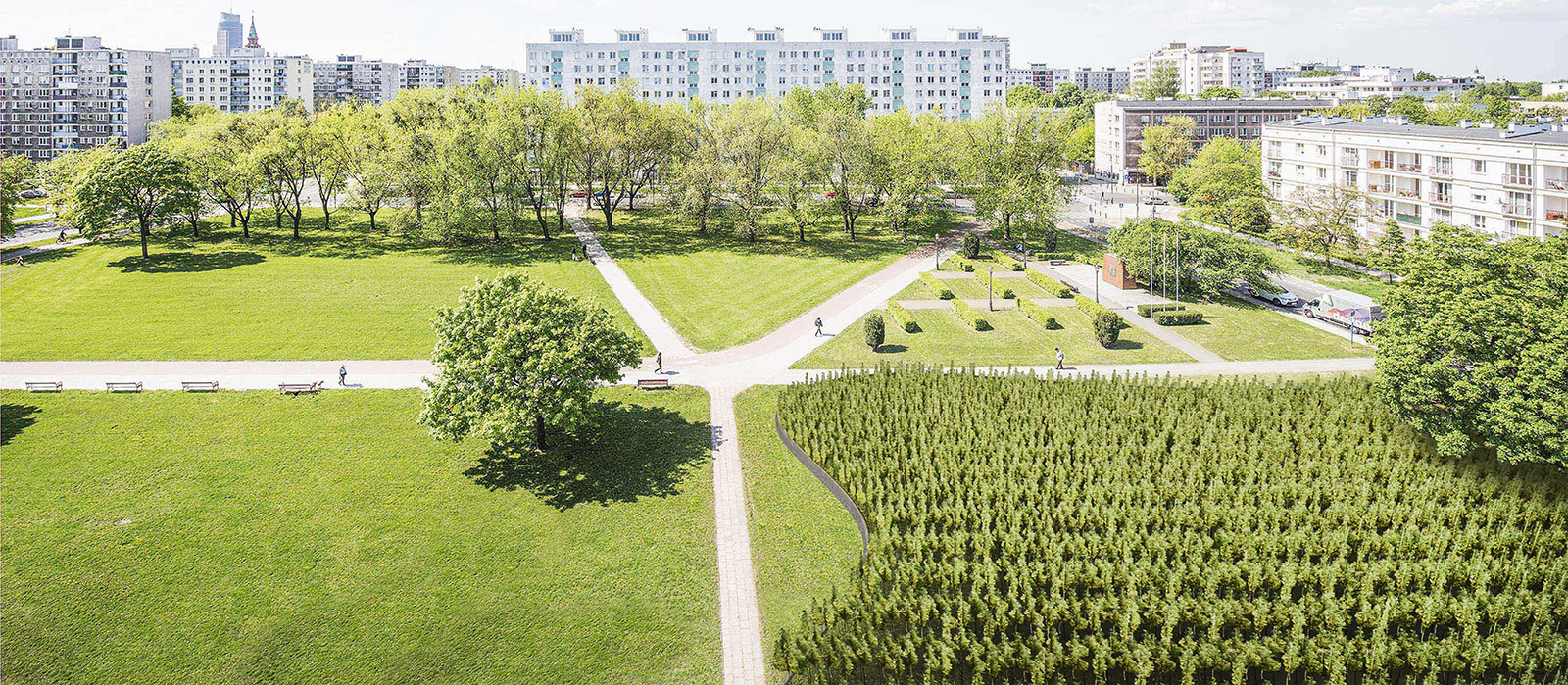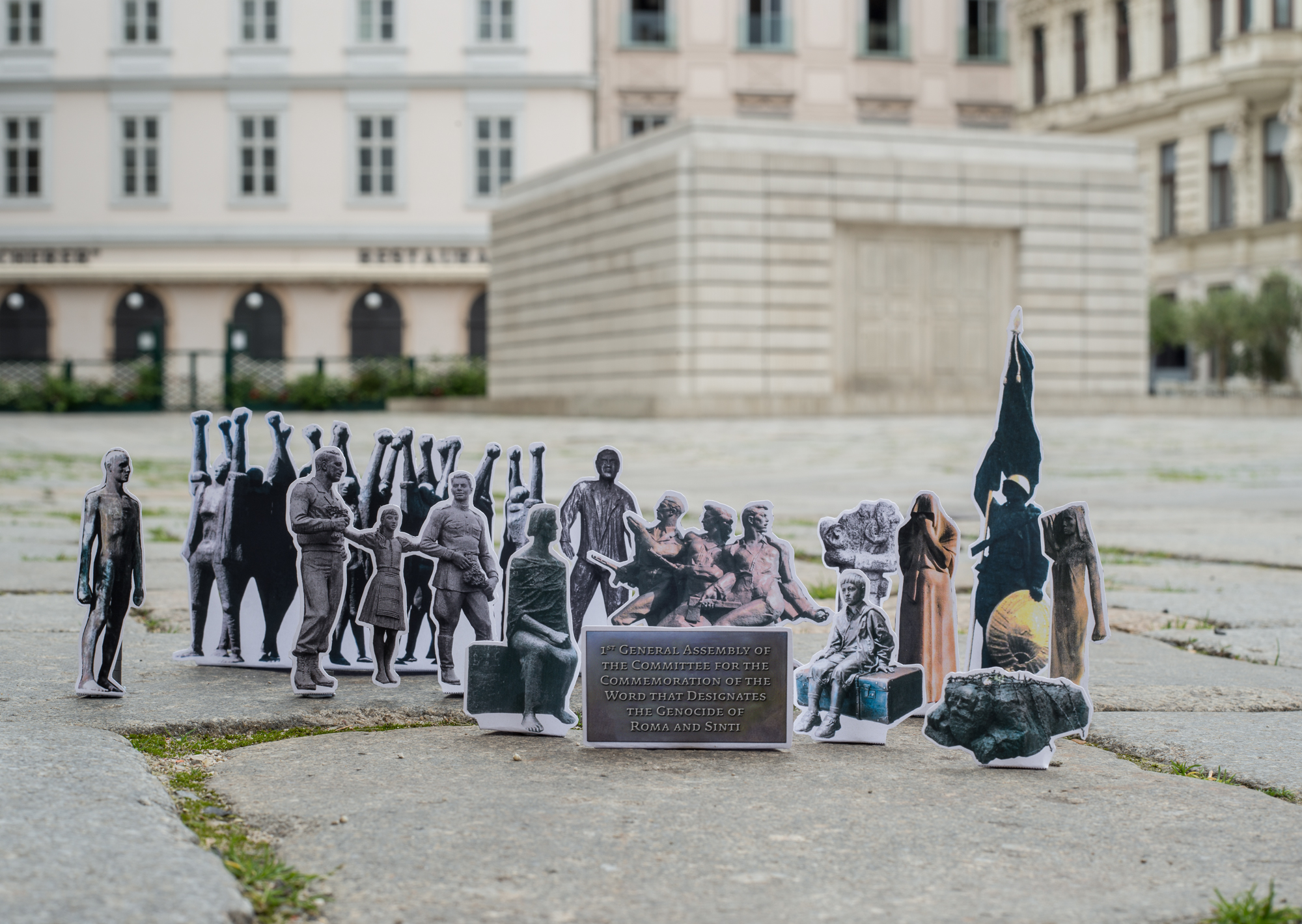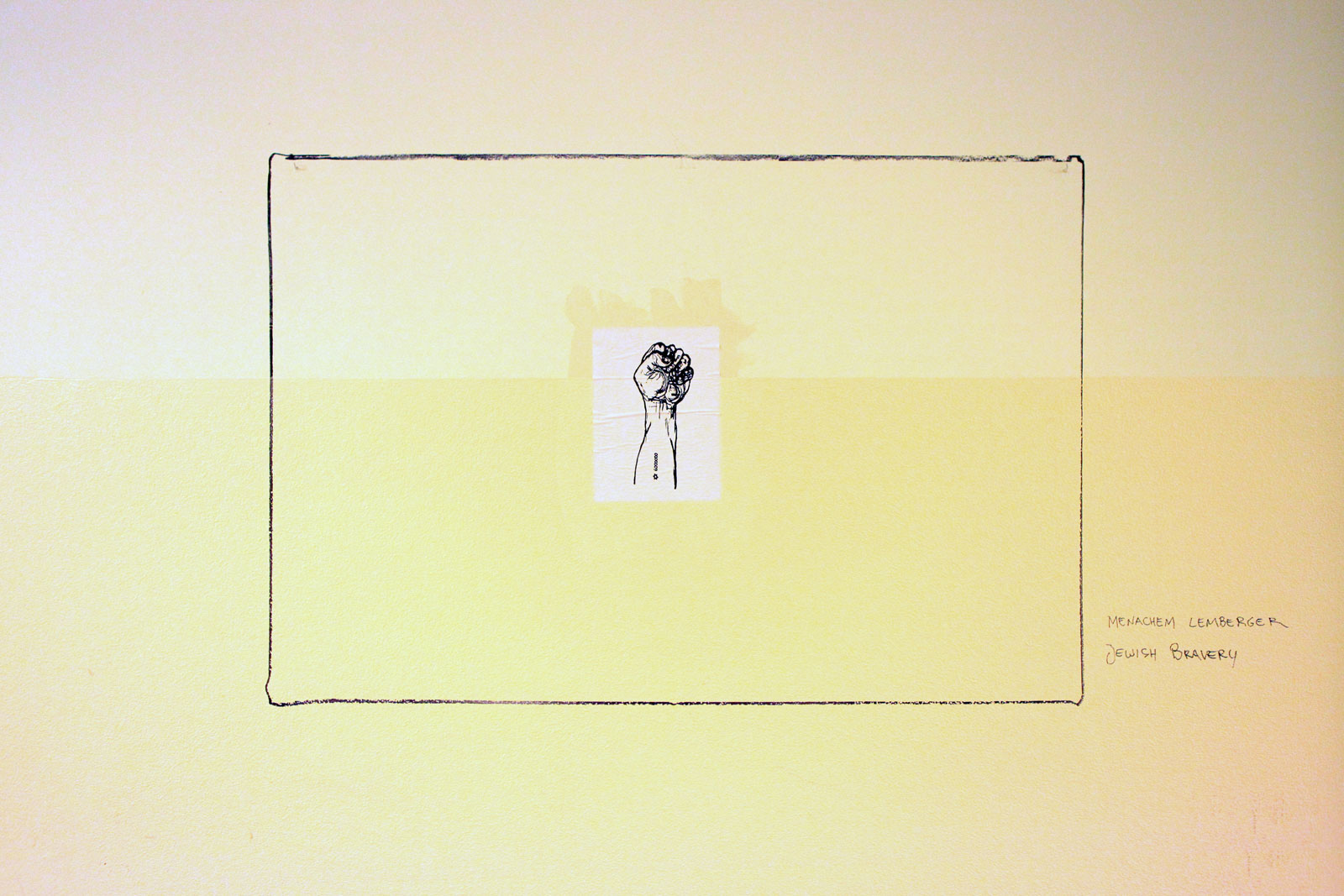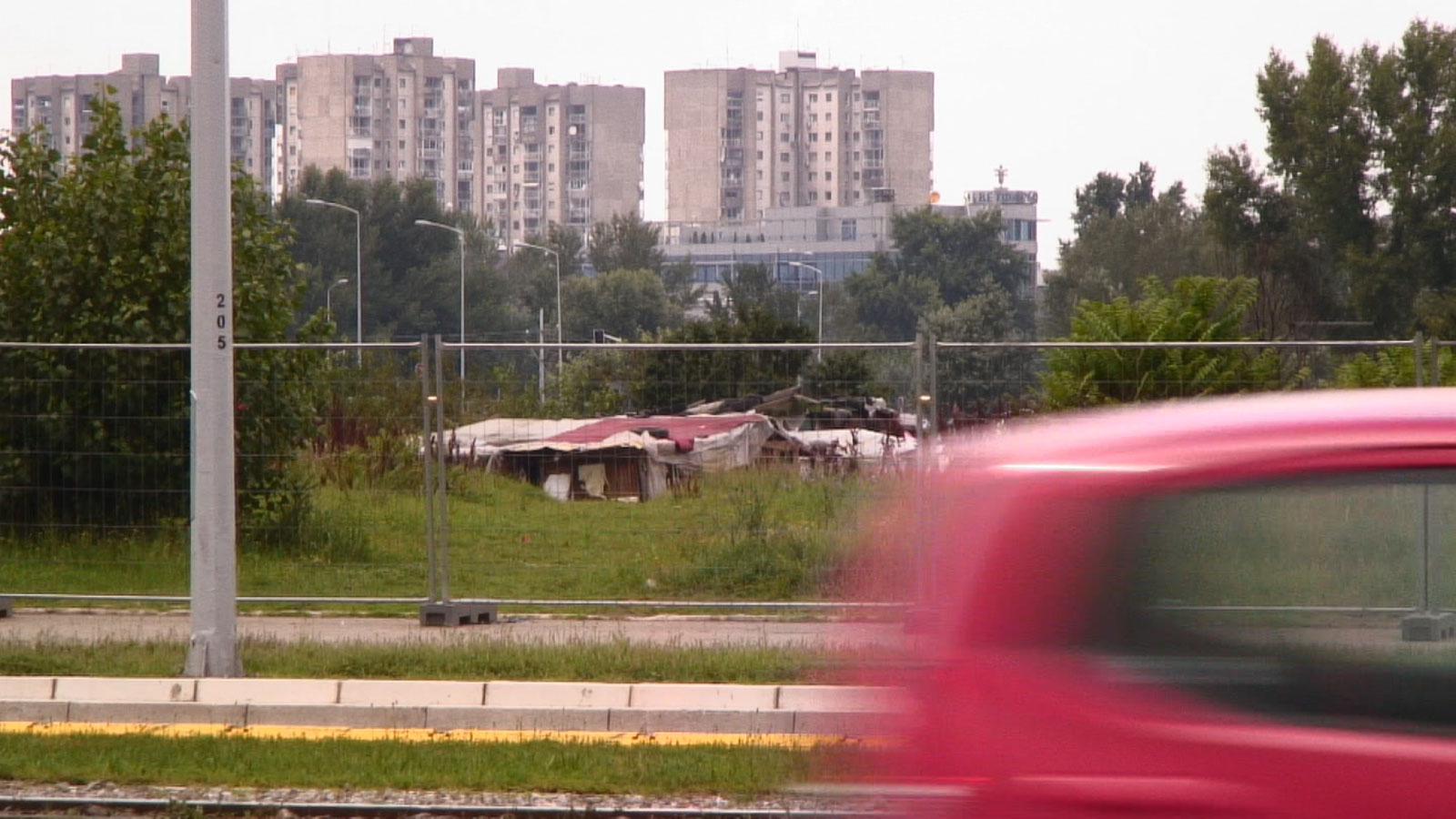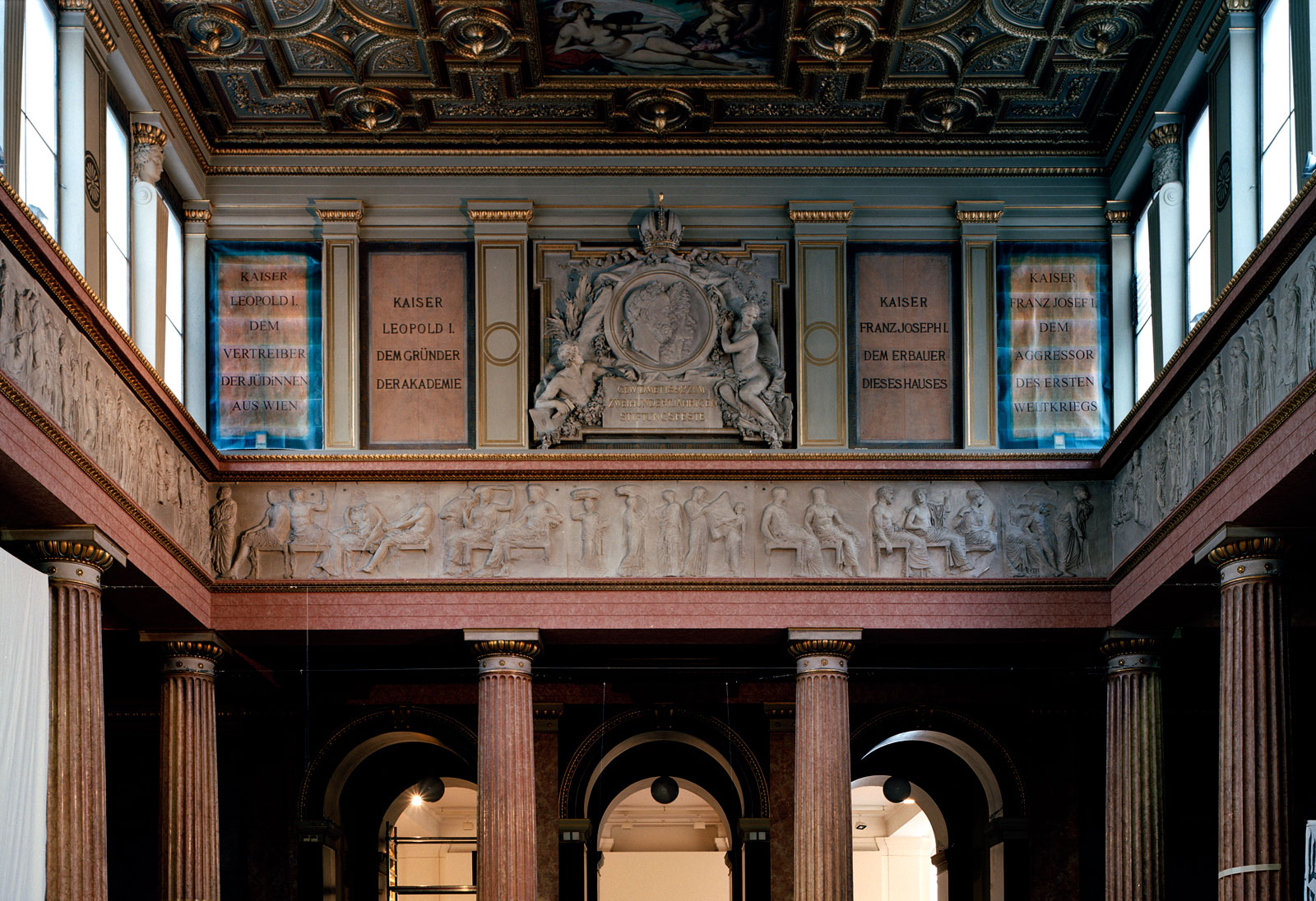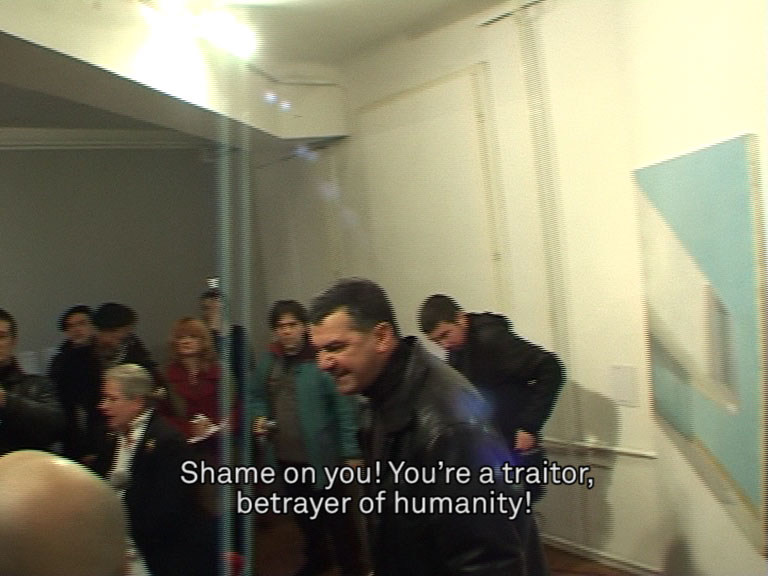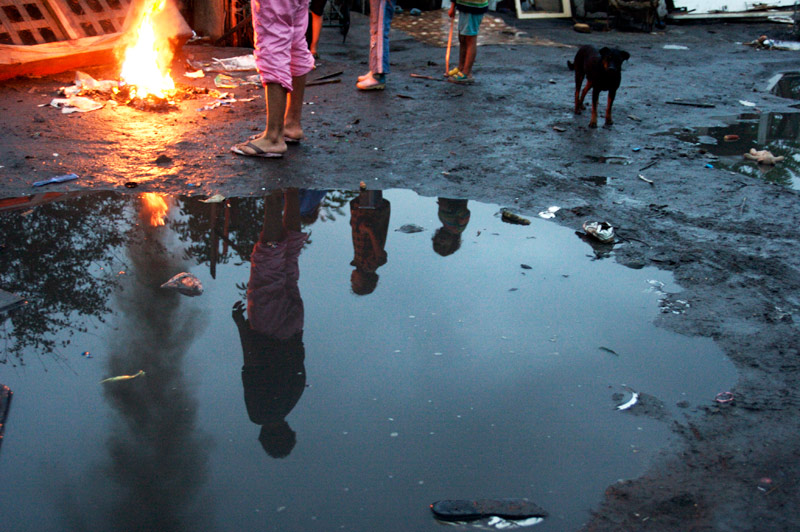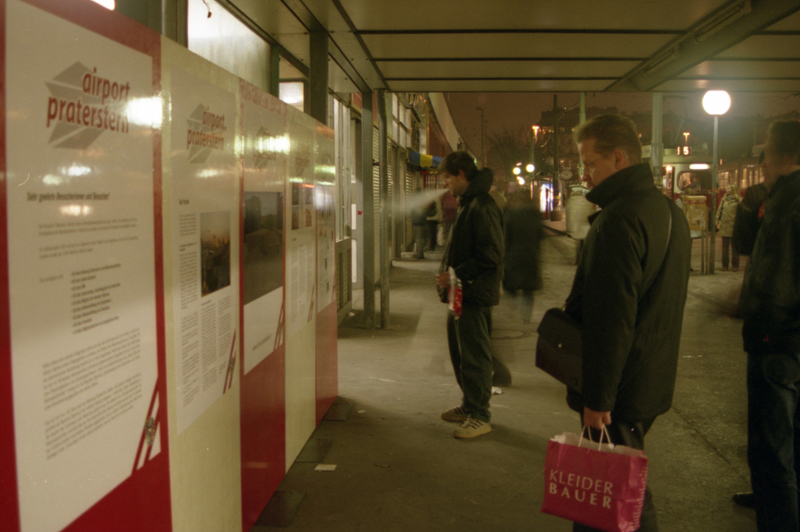S-C-H-A-N-D-E is a spatial installation consisting of six concrete objects and a video. It is a continuation of the project Schandwache, which deals with the contested monument to the antisemitic mayor of Vienna, Karl Lueger.
S-C-H-A-N-D-E
Spatial installation by Anna Witt, Simon Nagy, Gin Müller, Mischa Guttmann and Eduard Freudmann (2022)
S-C-H-A-N-D-E
Spatial installation by Anna Witt, Simon Nagy, Gin Müller, Mischa Guttmann and Eduard Freudmann (2022)
S-C-H-A-N-D-E is a spatial installation consisting of six concrete objects and a video. It is a continuation of the project Schandwache, which deals with the contested monument to the antisemitic mayor of Vienna, Karl Lueger.
All We Know About Them
Spatial installation (2021)
The project is an homage to Christian Boltanski’s Le Lycée Chases, one of the earliest visual art works dealing with the extermination of European Jewry. The installation consists of 24 backlit photographs on electroluminescent panels, showing students and a teacher of a high school class in Vienna in 1931. Through a choreography of illumination, juxtaposed with historical material of art and a school community in exile, the portraits question some myths of a modernist perspective on the Holocaust.
All We Know About Them
Spatial installation (2021)
The project is an homage to Christian Boltanski’s Le Lycée Chases, one of the earliest visual art works dealing with the extermination of European Jewry. The installation consists of 24 backlit photographs on electroluminescent panels, showing students and a teacher of a high school class in Vienna in 1931. Through a choreography of illumination, juxtaposed with historical material of art and a school community in exile, the portraits question some myths of a modernist perspective on the Holocaust.
Delusion
Spatial installation and intervention in public space by Luiza Margan and Eduard Freudmann (2021)
Modest alteration of the lettering in a monument at Graz city park, changing its dedication from Jahn to Wahn (delusion). Wahn indicates the antisemitic delusion Friedrich Jahn, the founder of the German gymnastics movement, suffered from.
Delusion
Spatial installation and intervention in public space by Luiza Margan and Eduard Freudmann (2021)
Modest alteration of the lettering in a monument at Graz city park, changing its dedication from Jahn to Wahn (delusion). Wahn indicates the antisemitic delusion Friedrich Jahn, the founder of the German gymnastics movement, suffered from.
Schandwache - Vigil of Disgrace
Intervention in public space by Anna Witt, Simon Nagy, Gin Müller, Mischa Guttmann and Eduard Freudmann (2020)
Schandwache – Vigil of Disgrace – took place at the contested monument to the former mayor of Vienna, Karl Lueger. Lueger is considered one of the most outspoken anti-Semites of the 20th century. The aim of the project was to protect graffiti, marking the monument as “disgrace”, from being removed by the authorities. Schandwache was carried out in cooperation with 16 cultural and political organizations from Vienna's civil society.
Schandwache - Vigil of Disgrace
Intervention in public space by Anna Witt, Simon Nagy, Gin Müller, Mischa Guttmann and Eduard Freudmann (2020)
Schandwache – Vigil of Disgrace – took place at the contested monument to the former mayor of Vienna, Karl Lueger. Lueger is considered one of the most outspoken anti-Semites of the 20th century. The aim of the project was to protect graffiti, marking the monument as “disgrace”, from being removed by the authorities. Schandwache was carried out in cooperation with 16 cultural and political organizations from Vienna's civil society.
Monument to a Myth
Installation in public space (2019)
The installation at Graz’s Befreiungsdenkmal aims to shift the confusing narratives around the commemoration of the departure of Allied occupation forces from Austria in 1955, the celebration of the country’s neutrality, and the myth of its victimhood at the hands of the Nazis.
Monument to a Myth
Installation in public space (2019)
The installation at Graz’s Befreiungsdenkmal aims to shift the confusing narratives around the commemoration of the departure of Allied occupation forces from Austria in 1955, the celebration of the country’s neutrality, and the myth of its victimhood at the hands of the Nazis.
Weinheber ausgehoben – Unearthing a Nazi Poet
Intervention in public space (2013) and reconfiguration of a monument (2019) by Plattform Geschichtspolitik
The project deals with a memorial to Austrian poet and Nazi Josef Weinheber (1892-1945) which stands at the Schillerpark in Vienna’s city centre. A temporary intervention, carried out in 2013, aimed at exposing the monument’s conflicted history. Public debate and years of negotiations with the authorities led to the permanent artistic reconfiguration and contextualization of the monument in 2019.
Weinheber ausgehoben – Unearthing a Nazi Poet
Intervention in public space (2013) and reconfiguration of a monument (2019) by Plattform Geschichtspolitik
The project deals with a memorial to Austrian poet and Nazi Josef Weinheber (1892-1945) which stands at the Schillerpark in Vienna’s city centre. A temporary intervention, carried out in 2013, aimed at exposing the monument’s conflicted history. Public debate and years of negotiations with the authorities led to the permanent artistic reconfiguration and contextualization of the monument in 2019.
The White Elephant Archive
Performance (2012-2015)
In his feature-length live performance Eduard Freudmann brings documents and objects as protagonists on the stage in order to consult them about how to speak of a horror once its witnesses are gone or silent. The performance is based on the artist's family archive, which was founded by his late grandmother and includes poems written by his grandfather while detained in Nazi concentration camps.
The White Elephant Archive
Performance (2012-2015)
In his feature-length live performance Eduard Freudmann brings documents and objects as protagonists on the stage in order to consult them about how to speak of a horror once its witnesses are gone or silent. The performance is based on the artist's family archive, which was founded by his late grandmother and includes poems written by his grandfather while detained in Nazi concentration camps.
A Stone Stands Here. Formations of Remembrance, 1949–
Spatial installation by Zsuzsi Flohr and Eduard Freudmann, music by Benjy Fox-Rosen (2016)
The work is based on a performance and intervention project titled "What they neglected, we did." (2015). It considers the spatial, aesthetic and political dynamics between self-organized interventions and the official governmental and municipal contribution to commemoration at Vienna’s Morzinplatz, a city-square where the Gestapo headquarters were located during the Nazi era.
A Stone Stands Here. Formations of Remembrance, 1949–
Spatial installation by Zsuzsi Flohr and Eduard Freudmann, music by Benjy Fox-Rosen (2016)
The work is based on a performance and intervention project titled "What they neglected, we did." (2015). It considers the spatial, aesthetic and political dynamics between self-organized interventions and the official governmental and municipal contribution to commemoration at Vienna’s Morzinplatz, a city-square where the Gestapo headquarters were located during the Nazi era.
"What they neglected, we did."
Performance and intervention in public space by Zsuzsi Flohr, Benjy Fox-Rosen, Eduard Freudmann, Eva Reinold, Luisa Ziaja (2015)
The project dealt with commemoration culture in public space in Vienna. It linked the elements of ritual, discourse and intervention in a performative setting. The project consisted of a panel discussion, a choir, an actress and a crew of workers who illegally erected a monument for a group of survivors who in 1951, had illegally built a memorial to the victims of the Gestapo.
"What they neglected, we did."
Performance and intervention in public space by Zsuzsi Flohr, Benjy Fox-Rosen, Eduard Freudmann, Eva Reinold, Luisa Ziaja (2015)
The project dealt with commemoration culture in public space in Vienna. It linked the elements of ritual, discourse and intervention in a performative setting. The project consisted of a panel discussion, a choir, an actress and a crew of workers who illegally erected a monument for a group of survivors who in 1951, had illegally built a memorial to the victims of the Gestapo.
The Monument May Be A Forest
By Gabu Heindl and Eduard Freudmann (2015)
The Monument May Be A Forest was the winner of the controversial competition "From Those You Saved", an initiative to build a monument to Polish Righteous gentiles who rescued Jews during the Shoah. The project proposal was based on planting a large tree nursery next to the POLIN Museum in Warsaw. Only if the initiative’s quarreling stakeholders would be able to agree on some disputed questions the tree saplings could be planted as a forest and become a monument.
The Monument May Be A Forest
By Gabu Heindl and Eduard Freudmann (2015)
The Monument May Be A Forest was the winner of the controversial competition "From Those You Saved", an initiative to build a monument to Polish Righteous gentiles who rescued Jews during the Shoah. The project proposal was based on planting a large tree nursery next to the POLIN Museum in Warsaw. Only if the initiative’s quarreling stakeholders would be able to agree on some disputed questions the tree saplings could be planted as a forest and become a monument.
1st General Assembly of the Committee for the Commemoration of the Word that Designates the Genocide of Roma and Sinti
Two-sided poster, A2 format (2013)
The work deals with the longstanding struggle for the acknowledgement of the Nazi genocide of Roma and Sinti which has had comparatively little effect. The consequence is a nearly total lack of its commemoration in Austrian public space. The group depicted in the poster consists of 12 anti-Fascist monuments in Austria. They form a committee to commemorate a term that actually does not exist.
1st General Assembly of the Committee for the Commemoration of the Word that Designates the Genocide of Roma and Sinti
Two-sided poster, A2 format (2013)
The work deals with the longstanding struggle for the acknowledgement of the Nazi genocide of Roma and Sinti which has had comparatively little effect. The consequence is a nearly total lack of its commemoration in Austrian public space. The group depicted in the poster consists of 12 anti-Fascist monuments in Austria. They form a committee to commemorate a term that actually does not exist.
Bezirksamt L-Stadt
Revisited
Intervention in public space, temporary installation (2011)
In this project an anti-Semitic history-information plaque got kidnapped from a Magistratisches Bezirksamt in Vienna (District Administration Office), and replaced with a reproduction of a Shoah survivor’s artwork. The plaque was then installed at nearby Open Space Gallery.
Bezirksamt L-Stadt
Revisited
Intervention in public space, temporary installation (2011)
In this project an anti-Semitic history-information plaque got kidnapped from a Magistratisches Bezirksamt in Vienna (District Administration Office), and replaced with a reproduction of a Shoah survivor’s artwork. The plaque was then installed at nearby Open Space Gallery.
Uglyville
Film by Eduard Freudmann and Ivana Marjanović (2010)
This film is a critical analysis of the interrelation of racism (i.e. anti-Romaism) and capitalism in socalled New Europe (Europe after 1989), but also an analysis of strategies of resistance to it. The starting point for the film was the partial demolition and fencing of a Roma slum next to Belville, a residential area erected to accommodate guests of the international sports event Universiade Belgrade 2009.
Uglyville
Film by Eduard Freudmann and Ivana Marjanović (2010)
This film is a critical analysis of the interrelation of racism (i.e. anti-Romaism) and capitalism in socalled New Europe (Europe after 1989), but also an analysis of strategies of resistance to it. The starting point for the film was the partial demolition and fencing of a Roma slum next to Belville, a residential area erected to accommodate guests of the international sports event Universiade Belgrade 2009.
Kaiserrelief
Spatial intervention by Plattform Geschichtspolitik (2010)
Two Austrian emperors are being honored in a relief at the assembly hall of the Academy of Fine Arts Vienna. The relief is framed by two inscriptions: “To Kaiser Leopold I, founder of the Academy” and “To Franz Joseph I, erector of this building.”
Plattform Geschichtspolitik tried to evoke a discussion about the memorial by adding two appendixes: “To Kaiser Leopold I, who expelled the Jews from Vienna” and “To Franz Joseph I, who triggered WWI.” These additional appendixes remain alongside the original descriptions to this day.
Kaiserrelief
Spatial intervention by Plattform Geschichtspolitik (2010)
Two Austrian emperors are being honored in a relief at the assembly hall of the Academy of Fine Arts Vienna. The relief is framed by two inscriptions: “To Kaiser Leopold I, founder of the Academy” and “To Franz Joseph I, erector of this building.”
Plattform Geschichtspolitik tried to evoke a discussion about the memorial by adding two appendixes: “To Kaiser Leopold I, who expelled the Jews from Vienna” and “To Franz Joseph I, who triggered WWI.” These additional appendixes remain alongside the original descriptions to this day.
The State of Exception Proved to be the Rule
Documentary by Eduard Freudmann and Jelena Radić (2008)
The film deals with the events around an exhibition of Albanian artists from Kosovo in Belgrade’s Kontekst Galerija. On February 7th, 2008, the opening of the exhibition was prevented by Serbian right-wingers. The film connects the incidents in Kontekst Galerija with the national and international political situation, the production of public opinion by media in Serbia and a theoretical analysis and interpretation of the situation.
The State of Exception Proved to be the Rule
Documentary by Eduard Freudmann and Jelena Radić (2008)
The film deals with the events around an exhibition of Albanian artists from Kosovo in Belgrade’s Kontekst Galerija. On February 7th, 2008, the opening of the exhibition was prevented by Serbian right-wingers. The film connects the incidents in Kontekst Galerija with the national and international political situation, the production of public opinion by media in Serbia and a theoretical analysis and interpretation of the situation.
Beograd Gazela – Travel Guide To A Slum
Book by Lorenz Aggermann, Eduard Freudmann, Can Gülcü (2008/2009)
This book provides documentation of a Roma slum in Belgrade, packed in the format of a travel guide book. It was published in Serbian, Romani and German language, received large attention by international media and is sold in the travel guide sections of book stores. The book is based on extensive research carried out between 2005 and 2007 during several longer stays in Belgrade. It provides essential information about the social and economic structures of a slum, about the inhabitants and their daily lives and exposes the complex mechanisms of marginalization and discrimination against Roma.
Beograd Gazela – Travel Guide To A Slum
Book by Lorenz Aggermann, Eduard Freudmann, Can Gülcü (2008/2009)
This book provides documentation of a Roma slum in Belgrade, packed in the format of a travel guide book. It was published in Serbian, Romani and German language, received large attention by international media and is sold in the travel guide sections of book stores. The book is based on extensive research carried out between 2005 and 2007 during several longer stays in Belgrade. It provides essential information about the social and economic structures of a slum, about the inhabitants and their daily lives and exposes the complex mechanisms of marginalization and discrimination against Roma.
Airport Praterstern
Intervention in public space by Michael Fleischner, Eduard Freudmann, Can Gülcü (2005)
In the name of the Republic of Austria the project announced the launch of the initiative Niemals Vergessen (Never Forget), which combined a utopian construction project and a shift of paradigm in terms of how the Republic deals with the Jews expelled from Vienna during Nazism. The construction project was a new airport at Vienna’s railway station Praterstern and it was presented to the public through the information booth, radio shows, newspaper articles, a website and an online discussion forum.
Airport Praterstern
Intervention in public space by Michael Fleischner, Eduard Freudmann, Can Gülcü (2005)
In the name of the Republic of Austria the project announced the launch of the initiative Niemals Vergessen (Never Forget), which combined a utopian construction project and a shift of paradigm in terms of how the Republic deals with the Jews expelled from Vienna during Nazism. The construction project was a new airport at Vienna’s railway station Praterstern and it was presented to the public through the information booth, radio shows, newspaper articles, a website and an online discussion forum.
